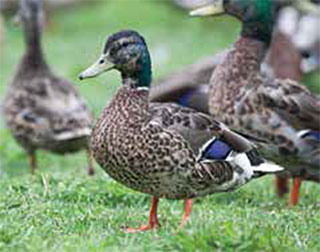By Jessie Barry, All About Birds from the Cornell Lab

In the dog days of summer, birds seem to disappear—the dawn chorus wanes and an odd silence takes hold in woodlands. A lot of birders hang up their binoculars until fall migration. But there’s no reason to stop birding. The birds are still there, they’re just keeping a low profile, because they’re replacing their feathers.
After breeding, the molting season kicks in. Molt is the systematic replacement of feathers. All birds do it—from hummingbirds to penguins. Birds have to molt in order to survive, because feathers wear out from physical abrasion and bleaching from the sun. Once a year (in the late summer for temperate species) birds grow an entirely new set of feathers through a complete molt.
As birds grow new flight feathers, they are particularly vulnerable. During wing molt, several of their feathers will be less than full length, producing gaps in their wings, so they are not as maneuverable or powerful in flight. To minimize attracting the attention of predators, many birds—such as sparrows, warblers, and thrushes—tend to vocalize infrequently and hide in vegetation.
Molting Strategies
Groups of birds employ different strategies to fit molt into their annual schedule. Most eastern songbirds, including Chestnut-sided Warbler, Baltimore Oriole, and Indigo Bunting, begin replacing their flight and body feathers shortly after their young fledge. They tend to undergo this complete molt on or near their breeding grounds, migrating south after they have a new set of feathers.
Some songbirds in the West, however, begin their migration south a bit before molting. Western summers can be extremely dry and desolate. So many species—including Western Kingbird and Lazuli Bunting—head off on a partial migration to the Mexican Monsoon region (southeast Arizona, New Mexico, and northwest Mexico) to molt. The monsoon rains brings an abundance of insects on which to feed. After molting their flight feathers, they continue their migration farther south to their wintering grounds.
Birding During Molt
Spotting molt in action is just a matter of taking a minute to look carefully at the feathers. Molting warblers and thrushes in woodlands tend to be tricky to see, but grackles and other blackbirds in the open country are often easy to spot. Birds in heavy molt tend to be scruffy overall—look for contrast between new and old feathers, and gaps in their wings where old feathers have been dropped and new ones have just started growing.
WOOD THRUSH SIGHTINGS
 Birds in molt can look unusual, like the Wood Thrush with a stubby tail pictured above left. Molting birds are also secretive. This eBird graph of reported Wood Thrush observations from birders in Upstate New York shows a noticeable dip in late July and August, even though the thrushes are still present. Explore eBird to learn where you can find Wood Thrushes and other birds.
Birds in molt can look unusual, like the Wood Thrush with a stubby tail pictured above left. Molting birds are also secretive. This eBird graph of reported Wood Thrush observations from birders in Upstate New York shows a noticeable dip in late July and August, even though the thrushes are still present. Explore eBird to learn where you can find Wood Thrushes and other birds.
DRAKES GO INCOGNITO

Brightly colored male ducks have an extra trick to avoid being conspicuous to predators during molt. Waterfowl, along with loons and grebes, lose all of their primary and secondary feathers at once, rendering them flightless for about a month. To help them hide when they can’t fly, male ducks grow a special set of camouflaged feathers, called eclipse plumage. In July, you may notice all the Mallards in a local park look scruffy and mostly brown, like they’re all females. Shortly after their wing feathers have regrown and they are able to fly again, drakes will regrow their brightly colored body feathers.
With an appreciation of molting, you’ll see that a motley looking bird in late summer is really another incredible stage of a bird’s life cycle. And you’ll appreciate how birds prepare for the long journeys of their fall migration